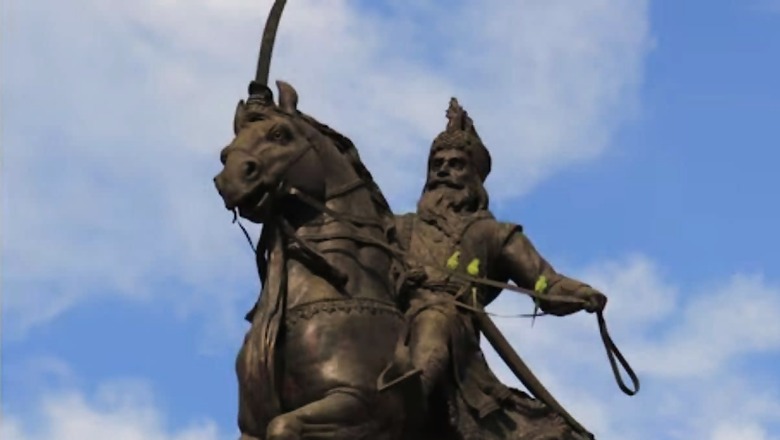
views
Multan, now in Pakistan, is home to the world’s largest repository of Sufi shrines. Its original names included Moolasthana, Kashyapura and Kaspatryus (mentioned by the ancient Greek historian, Herodotus). Moolasthana was also the first major ancient Tirthakshetra to be savaged by the Arab raider named Muhammad bin Qasim who desecrated the Vigraha of the grand Aditya temple, the cynosure of the city. This temple had a prior antiquity of at least eight hundred years before Qasim pillaged the place and Hindus had considered Moolasthana on par with, say, Kashi, Mathura, Ayodhya, and Rameswaram.
But there was another equally sacred temple in Moolasthana.
The sacred annals of Sanatana Dharma tell us that the celebrated Bhagavata, Prahlada had built a temple for Narasimha in Moolasthana. It was therefore eponymously known as the Prahladapuri temple and unlike the Aditya Mandir, it had withstood repeated Islamic ravages. All the way till 1992. According to some traditions, the Holika Dahan festival originated at Prahladapuri.
The history of the Prahladapuri temple is painfully similar to the tragic history of all Hindu temples in what is now called Pakistan. After Muslim rulers consolidated large parts of northwestern and northern India, Multan emerged as one of the most strategic and lucrative provinces. Under various Sultans, Muslim governors vied with one another to control this Iqta.
Even as early as in Iltutmish’s regime, Hindu political power had been permanently destroyed in this region. However, it is also an eminent testimony to the piety and the indomitable spirit of resistance that ordinary Hindus showed in safeguarding the Prahladapuri temple for almost a millennium under oppressive conditions.
Fast forward to 1810. We observe a brilliant renewal of the same undying spirit of Hindu resistance. By then, Islamic political power in Multan had been pretty much crushed but the societal composition and social dynamics of the city narrate a cautionary tale. Centuries of Muslim rule had obviously implanted a customary feeling in the community’s psyche: that they were the masters and the Kaffirs, the slaves.
On the other side, the Hindu community bristling under centuries of humiliation, was thirsting for freedom and vengeance. Both came in 1817-18 when the Maharaja Ranjit Singh decisively shattered the Afghan hold over Multan and mortified them in a fashion from which they are yet to recover.
In 1810, the Afghan warlord Muzaffar Khan was in command of Multan, and despite Ranjit Singh’s growing influence, the Hindus in the city were far from being liberated. Yet, as a community, they mustered the guts to raise the height of the Prahladapuri temple. The Muslims were naturally inflamed and retaliated, leading to tensions.
Cut to 1831.
That year, Alexander Burns, a Scottish military officer and diplomat visited Multan. This is what he writes in his Travels into Bokhara, “The city of Mooltan is upwards of three miles in circumference, surrounded by a dilapidated wall, and overlooked on the north by a fortress of strength. It contains a population of about 60,000 souls, one third of whom may be Hindoos; the rest of the population is Mahommedan…the Afghans have left the country, since they ceased to govern… At Mooltan we first saw the practice of religion amongst the [Sikhs]. In a veranda of the tomb of Shumsi Tabreezi, a [Sikh] Guru… had taken up his abode since the conquest of the city.”
Three realities of history emerge from this.
The first: Burns visited Multan after Maharaja Ranjit Singh had ejected the Afghans.
The second is the fact that Hindus and Sikhs comprised the minority population.
But the third is truly significant.
Historically, Hindu kings who had vanquished their Muslim counterparts did not demolish or usurp their masjids and maktabs and madrasas and dargahs. In a rare departure from that time-honoured practice of misplaced Hindu generosity, we here have an instance that epitomises the Sanskrit proverb, Paradaṇḍēnaiva parasya tāḍanam (Beat the enemy with his own stick; pay the enemy back in his own coin). Maharaja Ranjit Singh had converted the Sufi fanatic Shams-i-Tabrizi’s dargah into a quasi gurdwara. Shams-i-Tabrizi was the teacher of Jalal-ud-din Rumi.
We turn to Burns once again. With some poignancy, he describes the piety of the aforementioned Sikh Guru in Shams-i-Tabrizi erstwhile dargah: “We found him seated on the ground, with a huge volume [Guru Granth Sahib] in front of him; and a place covered with cloth, like an altar, at one end of the apartment. He opened the book at my request, and repeating the words ‘wahe guruji ka futteh’, touched the volume with his forehead, and all the Sikhs in attendance immediately bowed to the ground…the Guru waves a chouryy or a Tibet cow’s tail, over it, as if he were fanning an emperor. The Guru was free from pomp and pride, and gave a willing explanation to our enquiries.”
Which opens up another historical insight.
The downfall of the powerful; Sikh Empire in many ways can be likened to the fall of the Vijayanagara Empire. While the Vijayanagara Empire had safeguarded Sanatana Dharma in south India against Islamic invasions, the Sikh Empire had recovered vast swathes of Hindu territory lost to Islamic clutches. Maharaja Ranjit Singh had single-handedly brought the entire northwestern India back into the Sanatana fold for the first time after six hundred years of Islamic rule.
We have two eyewitness proofs for this historical truth.
The first is once again, by Alexander Burns. In the same description of the former dargah, he writes, “The presence of a Sikh priest, and the paraphernalia of his order, under the roof of a Mahommedan tomb, will furnish a good commentary on the state of that religion in this country: it is barely tolerated. In this city, which held for upwards of 800 years, so high a Mohammedan supremacy, there is now no public namaz; the true believer dare not lift his voice in public. The Eids and the Mohurum pass without the usual observances; the Allaho Acbar of the priest is never heard; the mosques are yet frequented, but the pious are reduced to offering up their orisons in silence. Such has been the state of things since Mooltan fell, in 1818, and yet the number of Sikhs is confined to that of the garrison, from four to five hundred men. The Mahommedans, who amount to about 40,000, suffer no other inconvenience from their new masters, who afford every protection to their trade. The Sikhs excuse themselves, by alleging, that they have not inflicted, in retribution, one fourth of their own sufferings at the hands of the Mahommedans. They are, l believe, correct in the averment.” (Italics added)
The second proof comes straight from the horse’s mouth. His name is Shah Waliullah and he predates Alexander Burns by a few decades. Waliuallah wrote prolific and panicked letters inviting Ahmad Shah Abdali to invade India to rescue Islam from the clutches of “the infidels” of various hues. He identified the Marathas and the Jats as the primary sources that instilled terror in the hearts of the ghazis.
Here are a few gems from Waliullah’s letters:
- “Among the non-Muslim communities, one is that of the Maratha…For some time past, this community has been raising its head, and has become influential all over Hindustan.
- In the countryside between Delhi and Agra, the Jat community used to till the land. In the reign of Shahjahan, this community had been ordered not to ride on horses, or keep muskets with them, or build fortresses for themselves. The sultans that came later became careless, and this community has used the opportunity for building many forts, and collecting muskets. In the reign of Muhammad Shah, the impudence of this community crossed all limits. And Surajmal, the cousin of Churaman, became its leader. He took to rebellion. Therefore, the city of Bayana which was an ancient seat of Islam, and where the Ulama and the Sufis had lived for seven hundred years, has been occupied by force and terror, and Muslims have been turned out of it with humiliation and hurt.
- Whatever influence and prestige is left with the kingship at present, is wielded by the Hindus…The story is long and cannot be summarised. What I mean to say is that the country of Hindustan has passed under the power of non-Muslims.
- Allah forbid, if the infidels continue as at present, and Muslims get further weakened, the very name of Islam will get wiped out.
- Allah forbid, if the power of the infidels remains in its present position, Muslims will renounce Islam.”Shah Waliullah died in 1762, his death coinciding with the decline of the Maratha power and the nascent resurgence of Muslim power under the Durranis. It was Maharaja Ranjit Singh who not only quelled the resurgence but heralded a powerful era of assertive Hindu revival as we have seen.Which brings us back to Multan and the famed Prahladapuri temple. This is how Burns describes it: “In the interior of the [Multan] fort, there is the Hindoo temple, which its votaries believe to be of boundless antiquity…this Hindoo temple, which goes by the name of Pyladpooree [Prahladapuri], is a low building, supported by wooden pillars, with the idols Hooneeman [Hanuman] and Guneesa [Ganesha] as guardians to its portal. It is the only place of Hindoo worship in Mooltan; we were denied entrance to it.”The only place of Hindu worship in Multan. In 1831. The temple, doggedly protected by a small garrison of Sikhs against great odds. The garrison also provided shelter to the minority Hindu and Sikh community in the city. Outnumbered by a ratio of 3:1.In 1849, the Sikh Empire sputtered to a permanent halt. And with it, the Hindu community in Multan lost its protective armour.The Prahladapuri Temple survived in a perilous fashion for nearly 150 years after this. In the 1970s, the Moola-Murti (the main deity in the temple’s sanctum sanctorum) was transported to a temple in Haridwar after the Pakistan Government’s Evacuee Trust Property Board took control of the temple. Eventually, a madrasa was built in the temple’s premises.In 1992, a fanatical Muslim mob completely demolished the temple. It was their vengeance for the demolition of the disputed structure, also known as the erstwhile Babri Masjid.The author is the founder and chief editor, The Dharma Dispatch. Views expressed are personal.




















Comments
0 comment